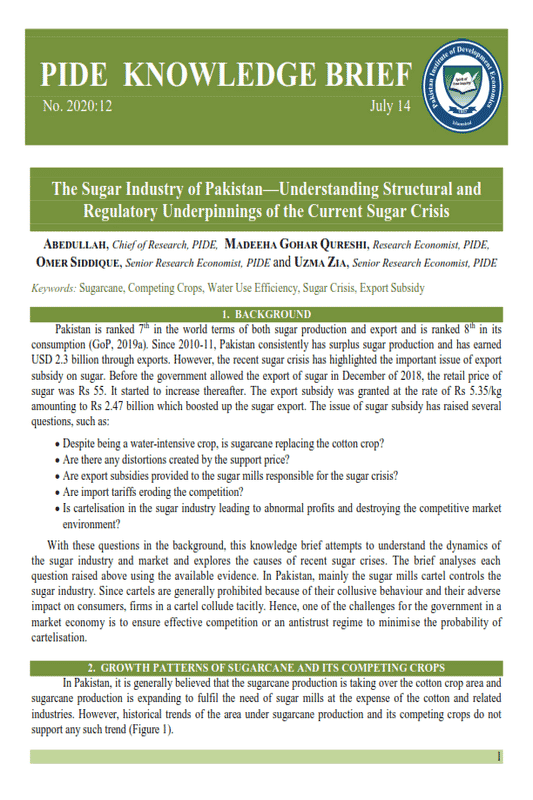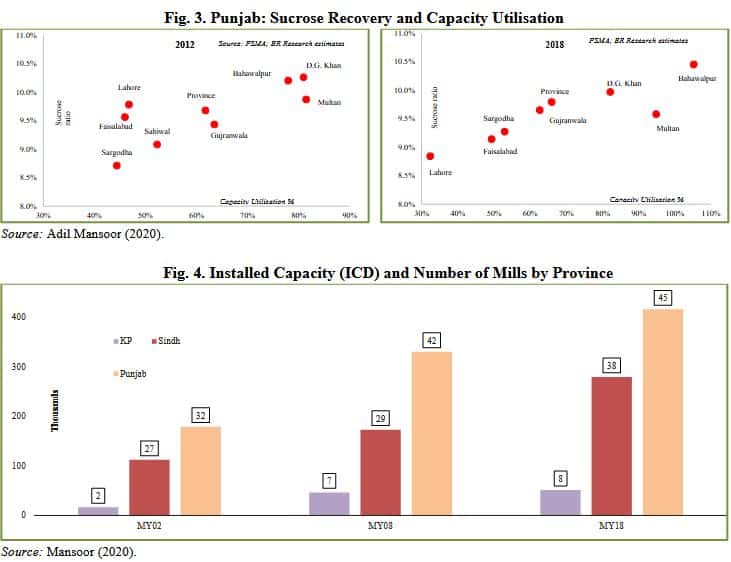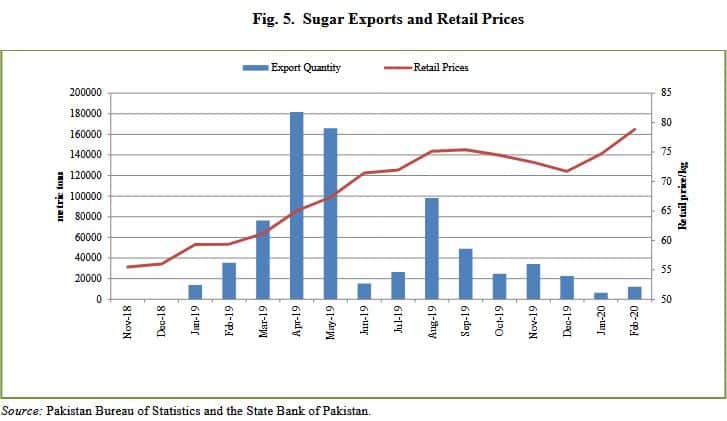
Pakistan Institute of Development Economics
- Home
Our Portals
MenuMenuMenuMenuMenuMenuMenu - ResearchMenuMenuMenuMenuMenuMenuMenu
- Discourse
- The PDR
- Our Researchers
- Academics
- Degree Verification
- Thesis Portal
- Our Portals
The Sugar Industry Of Pakistan—Understanding Structural And Regulatory Underpinnings Of The Current Sugar Crisis
The Sugar Industry of Pakistan—Understanding Structural and Regulatory Underpinnings of the Current Sugar Crisis
Abedullah, Chief of Research, PIDE, Madeeha Gohar Qureshi, Research Economist, PIDE, Omer Siddique, Senior Research Economist, PIDE and Uzma Zia, Senior Research Economist, PIDE
Keywords: Sugarcane, Competing Crops, Water Use Efficiency, Sugar Crisis, Export Subsidy
BACKGROUND
Pakistan is ranked 7th in the world terms of both sugar production and export and is ranked 8th in its consumption (GoP, 2019a). Since 2010-11, Pakistan consistently has surplus sugar production and has earned USD 2.3 billion through exports. However, the recent sugar crisis has highlighted the important issue of export subsidy on sugar. Before the government allowed the export of sugar in December of 2018, the retail price of sugar was Rs 55. It started to increase thereafter. The export subsidy was granted at the rate of Rs 5.35/kg amounting to Rs 2.47 billion which boosted up the sugar export. The issue of sugar subsidy has raised several questions, such as:
- Despite being a water-intensive crop, is sugarcane replacing the cotton crop?
- Are there any distortions created by the support price?
- Are export subsidies provided to the sugar mills responsible for the sugar crisis?
- Are import tariffs eroding the competition?
- Is cartelisation in the sugar industry leading to abnormal profits and destroying the competitive market environment?
With these questions in the background, this knowledge brief attempts to understand the dynamics of the sugar industry and market and explores the causes of recent sugar crises. The brief analyses each question raised above using the available evidence. In Pakistan, mainly the sugar mills cartel controls the sugar industry. Since cartels are generally prohibited because of their collusive behaviour and their adverse impact on consumers, firms in a cartel collude tacitly. Hence, one of the challenges for the government in a market economy is to ensure effective competition or an antistrust regime to minimise the probability of cartelisation.
GROWTH PATTERNS OF SUGARCANE AND ITS COMPETING CROPS
In Pakistan, it is generally believed that the sugarcane production is taking over the cotton crop area and sugarcane production is expanding to fulfil the need of sugar mills at the expense of the cotton and related industries. However, historical trends of the area under sugarcane production and its competing crops do not support any such trend (Figure 1).

If we compare the areas allocated to sugarcane and its competing crops in 2012-13 with those in 2018-19, it can be seen that the area under rice and maize cultivation has increased manifold as compared to the area under sugarcane cultivation. This implies that cotton is declining primarily because of the increase in the area under maize and rice cultivation and not because of an increase in the area under sugarcane cultivation. Further investigation reveals that the higher productivity of rice and maize makes these crops more profitable. Therefore, it is the financial incentives that have encouraged farmers to shift from cotton to rice and maize crops (Figure 2).
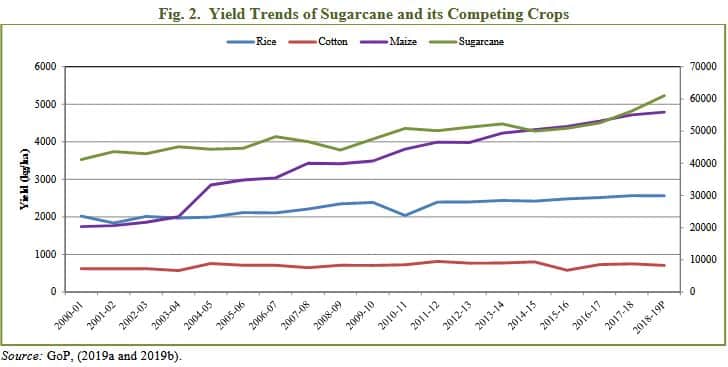
Punjab contributes more than 64 percent to sugarcane and 79 percent to cotton production. It is generally believed that sugarcane production is replacing cotton production, which is an important input for the textile industry. Hence, any change taking place in Punjab should reflect in the national statistics. However, the data shows that sugarcane production has increased at the expense of the cotton crop only in Southern Punjab but not in the other parts of Punjab. District-wise area allocation reveals that both sugarcane and cotton have lost areas in Central, Western, and Northern Punjab. In Southern Punjab, however, the area under sugarcane and other competing crops, such as rice and maize, have increased. The increase in rice and maize area is even higher than the increase in the sugarcane area. Low productivity and low profitability make cotton production uncompetitive in the existing production system. Therefore, it is safe to conclude that the increase in sugarcane production is not responsible for the decline in cotton production. Rather, the increase in profitability of competing crops, driven by higher productivity in comparative terms, is the prime reason for the loss in the cotton production over time.
One reason for the increasing area under sugarcane cultivation in Southern Punjab is the higher sucrose recovery levels as indicated in Figure 3 (Mansoor 2020). This has motivated sugar mills to offer contracts to farmers to grow sugarcane in Southern Punjab to meet the maximum sucrose requirements from Southern Punjab. This, in turn, has motivated the farmers in Southern Punjab to increase the area for the sugarcane crop. Higher supply has led the sugar mills to enhance the existing crushing capacity over time, which can be seen from Figure 4.
 3. POSSIBLE CAUSES OF GROWTH IN THE SUGARCANE AREA
3. POSSIBLE CAUSES OF GROWTH IN THE SUGARCANE AREA
3.1. Support Price
It is important to note that farmers’ profitability from the sugarcane crop is not primarily linked to the support price as in the case of wheat. In the case of wheat, the support price is implemented at the farm gate level because the government procures 60 percent of wheat from farmers for storage and distribution purposes. On the other hand, the government does not procure sugarcane, making it hard to implement the support prices at the farm gate level. Therefore, it is reasonable to conclude that the support price has not contributed to the expansion of sugarcane production area at the expense of its competing crops.[1] Rather, the sugarcane support price is only a benchmark against which the actual price can be gauged. However, both the perishable nature[2] of the crop and transportation restrictions[3] provide monopsony power to sugar mills in their respective areas. The violation of competitive market conditions contributes towards higher profitability of sugar mills hurting farmers’ returns.
3.2. Climatic Conditions
Climatic conditions also play an important role in deciding cropping patterns in an area. Sugarcane is not only more resilient against extreme weather conditions but the probability of a pest attack is also the least among its competing crops. Thus, the farmers consider it a safer and securer crop against environmental shocks compared to cotton, rice, and maize. The risk-averse nature of farmers nudges them towards less risky enterprises. Furthermore, the support price mechanism (though non-implementable by the government), along with the mandatory crushing law, still provides some level of protection to the farmers. Hence these two factors together have made sugarcane less risky compared to the competing crops.
Nevertheless, cotton is considered a lifeline for the economy of Pakistan. It has a 0.8 percent share in GDP and contributes 4.5 percent to the agriculture value addition. The lack of investment in developing high yielding varieties of cotton encourages farmers to explore alternative options that are more profitable than cotton. Therefore, one can conclude that the higher profitability, lower risk, and price security drive the growth of the sugarcane area.
WATER USE EFFICIENCY AMONG COMPETING CROPS
A common perception exists that sugarcane is a water-intensive crop compared to its competing crops. Therefore, it is generally held that sugarcane production should not be encouraged given the looming water crisis. In contrast, those who support the expansion in sugarcane production, argue that water use efficiency (WUE) of sugarcane is higher than its competing crops. WUE is estimated by dividing yield (GoP, 2019) with water usage (AgNews, 2019; Abedullah and Zia, 2020). The estimates show that sugarcane is highly water-efficient because the amount of water required to produce 1 kg of raw cotton can produce 8.6 kg (=0.002/0.000233) of sugarcane. Similarly, the amount of water required to produce 1 kg of rice can produce 10.9 kg (=0.002/0.000183) of sugarcane (Table 1). However, WUE based on the quantity produces misleading evidence because the market value of 1 kg of cotton is several times higher than the market value of 1 kg of sugarcane. The same is true in the case of rice and maize. Nevertheless, a farmer’s main concern is to earn money and a higher quantity from one litre of water has no meaning for them. Therefore, WUE needs to be redefined and should be based on the monetary benefits that one litre of water generates.
Therefore, first, we estimated revenue per acre by multiplying yield (GoP 2019) with prices (AMIS, 2019). Then we estimated revenue from one litre of water used in sugarcane production and its competing crops (Table 1). Our results reveal that the same amount of water that generates Re 1 from sugarcane production generates Rs 3 (=0.0246/0.0085=0.0258/0.0085) from both cotton and maize production and Rs 1.7 (=0.0146/0.0085) from rice production. This demonstrates that WUE of cotton, maize, and even of rice crops is higher than WUE of the sugarcane crop. We also estimated net return per acre after deducting cost (SBP 2019) from revenue and also net return per litre of water (Table 1). The difference in terms of net return from one litre of water was larger. The amount of water that generates a net return of Re 1 from sugarcane production generates generating Rs 4 (=0.010045/0.002581), Rs 3.4 (=0.008661/0.002581), and Rs 2.6 (=0.006694/0.002581) in cotton, maize, and rice production, respectively. This demonstrates that WUE, in terms of net return, is highest of cotton followed by maize and rice. For water conservation at the national level, the country needs to promote the cultivation of cotton and maize.
_______________________________
[1]Learning from comparative growth patterns of sugarcane and its alternative crops (Figures 1 and 2), one can see that crops that do not have any support prices like rice and maize have also grown at the expense of cotton. Hence, the support price of sugarcane have nothing to do with its growth rather higher productivity and profitability is the main drivers of its growth.
[2]1 Ha sugarcane farm yields 60 tons of sugarcane which cannot be stored like wheat. Hence given the bulk of produce, sugarcane farmer is compelled to take it to the nearest mill.
[3]According to the law, a sugar mill has a defined area in which no other mills can purchase the produced sugar raw material from farmers. Hence this very structure creates a monopsony for sugar by the millers in their designated area according to the License Raj.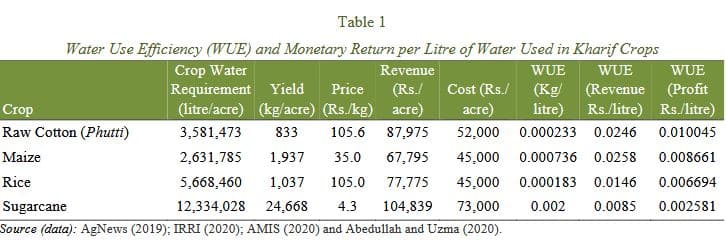 5. PROTECTION THROUGH REGULATORY DISTORTIONS
5. PROTECTION THROUGH REGULATORY DISTORTIONS
It has been argued that the perennial nature of the sugarcane crop and its perishable nature create demand for the protection, both at the farm and sugar mill level, to get the industry to flourish and survive. In this context, several regulatory distortions at the farm and industry level have been introduced to protect the interests of both farmers and millers (Box 1). However, in fact, the majority of distortions in the system protect the interest of sugar mills only and in some cases even at the expense of farmers’ welfare. On the one hand, sugar mills do not follow the minimum purchasing price (price support) fixed by provincial governments and, on the other hand, farmers are bound to sell their produce to local sugar mills located in the same area (the boundary area of each sugar mill is defined). It means that farmers cannot sell their produce at competitive prices to sugar mills located in other areas. Hence, sugar mills exploit farmers by offering lower prices because of the absence of competition across mills.
The sugar mills benefit from the regulatory distortions in many ways. Firstly, they get benefits by paying low prices to farmers. Secondly, barriers to new entries and a 40 percent customs duty on sugar imports creates economic distortions in favour of sugar mills. However, geographical barriers to the shifting of milling plants discourage competition and create inefficiencies in the sugar industry. Removing such barriers could lead to developing a cluster of sugarcane production in specialised areas of sugar production. At the same time, however, it must be mentioned that the mandatory crushing law provides protection to farmers, which cannot be ignored.
| Box 1 Details of Different Distortions to Protect Farmers and Sugar Mills Distortion at Farm Level: (a) Mandatory Crushing Law: This law bounds mills to buy sugarcane from farmer within its zone as long as the transaction is made on minimum notified prices for sugarcane. (b) Support Price: It is the minimum notified price that mills need to pay to farmers but need to de-couples sucrose recovery(raw material quality) from its pricing. (c) Risk Return distortion:The provincial government notified at the beginning of the season based on the recommendation by Agricultural Policy Institute, MNFS&R; creates a guaranteed return, against minimal risk covered through farmer’s crop insurance. Distortions at Mills Level: (a) License Raj: The new entry has been restricted in the sugar industry by introducing License Raj as a barrier because each new entrant requires a NOC from the province. (b) Import Controls: Domestic Industry is protected through 40 percent customs duty on sugar import. (c) Geographical Barriers: Crop zone changes with changing climate patterns, but the ban on the shifting of milling plants discourages competition. |
DISSECTING THE RECENT SUGAR CRISIS
During 2016-17 and 2017-18, the production of sugarcane and sugar was much higher than the national requirements. The surplus supply motivated provincial governments to increase the support price. The data shows that support prices had not been increased since 2015-16. In 2019, the announcement to increase sugarcane support prices was made at a very late stage when the crushing season had already started. Due to the delay in the announcement, the objective to attract higher area for sugarcane could not be achieved. Resultantly, there was a slight decrease in sugarcane cultivated area. It also resulted in competition between sugar mills to purchase sugarcane during the 2019-20 crushing season, which forced sugar mills to offer about 15 percent higher prices all over the country than the announced support prices to meet their sugarcane needs.
On December 19, 2019, the Pakistan Sugar Mills Association (PSMA) announced the closure of crushing to pressurise farmers and the provincial governments. Finally, a representative of PSMA met with the cabinet committee on the sugar sector on January 6, 2020. After the meeting, PSMA announced the resumption of sugarcane crushing. After the resumption, the sugarcane prices further increased but sugar prices also increased by Rs 1.28/kg. This demonstrates that in contrast to the previous year there was a shortage of sugarcane and was not sufficient to meet the demands of sugar mills.
Furthermore, it also signals the reduction in sugar supply during 2019. Despite that, however, the Economic Coordination Committee (ECC), at the recommendation of the Sugar Advisory Board (SAB), approved the export of 1.0 and 0.10 million tons of sugar on October 2, 2018, and December 4, 2019, respectively. During the same meeting, the Secretary Ministry of National Food Security and Research raised the concern over low production of sugarcane due to water shortages and reduction in the area allocated to the crop. In a subsequent meeting of SAB, Punjab raised the concern about the increasing prices of sugar in the local market but still, the ban on export was not recommended by SAB. It was revealed in the meeting that the net stocks were at negative 0.191 million tons. However, the belief was that the increasing prices of sugar were mainly the result of hoarding and not of export.
The retail price of sugar started to increase in December 2018 when the export of sugar was allowed (Figure 5). The retail price was the lowest at Rs 55.99/kg in November 2018 but by June 2019 it had reached Rs 71.44/kg. It was mainly due to the export of sugar, which put pressure on the leftover stock and increased the gap between supply and demand. The price increased by Rs 16/kg within seven months. Similarly, a major increase in ex-mill price (from Rs 51.64 to Rs 63.59) took place during the same period, which is about Rs 12/kg (Sugar Inquiry Report 2020). The retail prices further increased from Rs 71.44 to Rs 74.64 from July 2019 to January 2020 but PSMA denied the facts by claiming that the ex-mill price of sugar had not changed. It is important to note that there was no increase in GST or other taxes. Furthermore, the prices of sugarcane and other inputs remained stable during this period. In the presence of strong signals of increasing prices in the local market, the government reacted slowly to cancel the export permit, which aggravated the sugar crises in the country.
THE WAY FORWARD
The analysis of the way the sugar market and policies work in Pakistan shows that most of the problems stem from both overregulation and the lack of competition. If the market is deregulated, with free entry and exit, the intensive regulations and repeated interventions would not be needed. Moreover, in an environment of open market competition even mandatory crushing laws are not required. These laws weaken the price signal for the market and have led the farmers in the past to over-invest in sugarcane cultivation and the millers to maintain higher stocks than needed. Therefore, the issue is not whether the protection is needed for the sustainability of sugar markets; the issue is whether the current regime is sending wrong signals to the farmers and the sugar mill owners for cartelisation in the sugar industry. Restrictions on the entry of new mills through the License Raj distort the free market mechanism both for the millers and the farmers.
Similarly, import tariffs of 40 percent on sugar imports do not let the domestic prices respond to the changes taking place in the international market, shielding the domestic sugar industry from the competition in the international markets. For example, in periods of excess supply, the sugar mill owners get export quotas and subsidies whereas in periods of shortages they make huge profits in the domestic market. Further, looking at international best practices in sugar production, we find that countries having a comparative advantage mainly earn from sugar by-products, which have comparatively high international prices than sugar. In these countries, sugar is treated as a by-product and sold at a low price. These countries mainly depend on by-products such as ethanol for earnings. Pakistan has heavily protected the sugar industry, which creates disincentives for the domestic sugar industry to compete in the international market by developing sugar by-products.[4]
KEY TAKEAWAYS
- Expansion in the sugarcane production area is not responsible for replacing the cotton area. Rather it is the inefficient cotton production technologies that make cotton a less profitable crop compared to the competing crops (rice, maize, and sugarcane).
- The support price for sugarcane is only notional because the government does not procure sugar and, hence, there is no mechanism in place to enforce it. Sugarcane is sold above the support price whenever there is a shortage and below the support price when there is a surplus.
- The License Raj limits new entrants into the sugar industry. It creates cartelisation and leads to an increase in the profitability of sugar mills only. Similarly, trade barriers like import tariffs need to be removed or rationalised. Both these measures may lead to an efficient allocation of resources in this sector and an improvement in the welfare of local consumers.
- Price quota and subsidies have been used as a tool for offloading the surplus supply of sugar and to fill the gap between supply and demand. However, the government failed to take a timely decision in light of available information, which led to the recent sugar crisis.
- Therefore, the deregulation of the sugar market is extremely important to promote free trade mechanisms where price signals can be effectively conveyed to all stakeholders to attract investment and increase competitiveness.
____________________________
[4] Pakistan does produce ethanol but compared to international comparison is negligible. Further the environmental damage from ethanol production also needs to be taken into account.
REFERENCES
Abedullah and Zia, Uzma (2020). Unravelling water use efficiency in sugarcane and cotton production in Pakistan. (PIDE Policy Viewpoint No. 2020:19).
AgNews (2019). Agricultural solutions to help curb India’s water woes. AgNew August 23, 2019. http://news.agropages.com/News/NewsDetail—31717.htm
AMIS (2020). Agriculture marketing information service. Directorate of Agriculture (Economics and Marketing), Punjab, Lahore. http://www.amis.pk/
GoP (2019a). Pakistan economic survey 2018-19. Islamabad: Ministry of Finance, Government of Pakistan.
GoP (2019b). Agricultural statistic of Pakistan 2019. Islamabad: Ministry of National Food Security and Research (MNFSR). Government of Pakistan.
IRRI (2020). Rice knowledge bank. International Rice Research Institute (IRRI). http://www. knowledgebank.irri.org/step-by-step-production/growth/water-management
Mansoor, Adil (2020). Regulatory roots of the sugar crisis: Asking the right questions. Presented in PIDE webinar on 10th April 2020.

